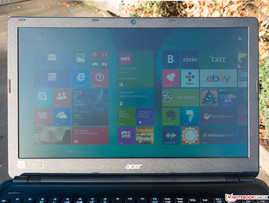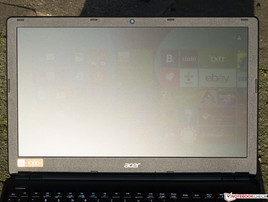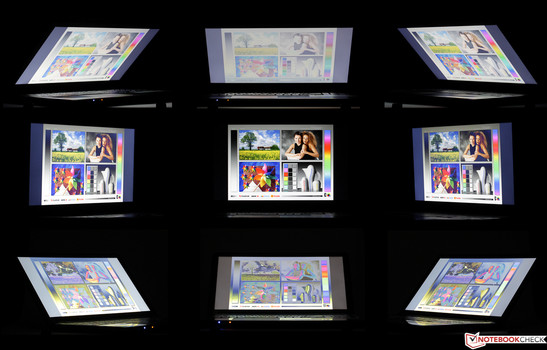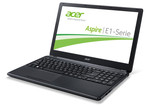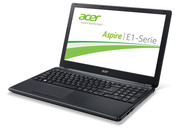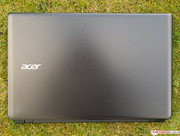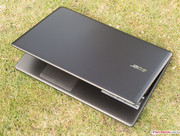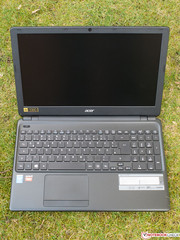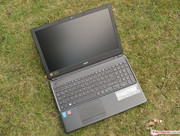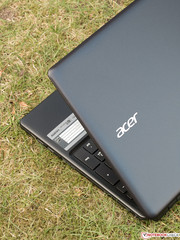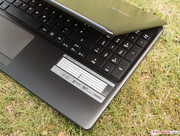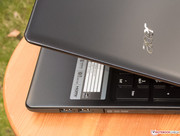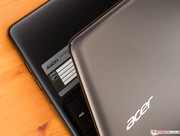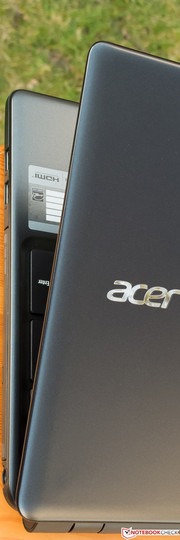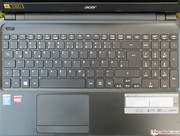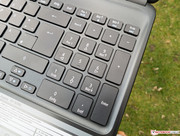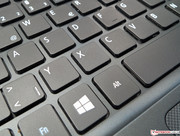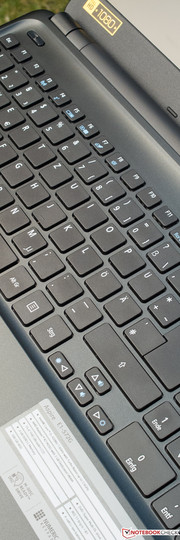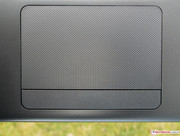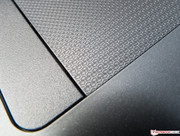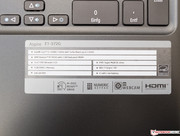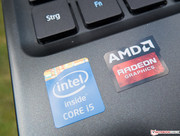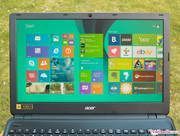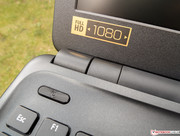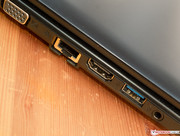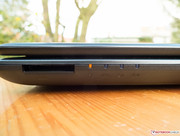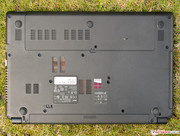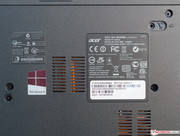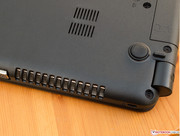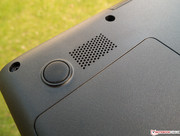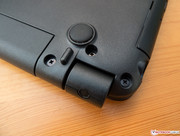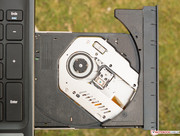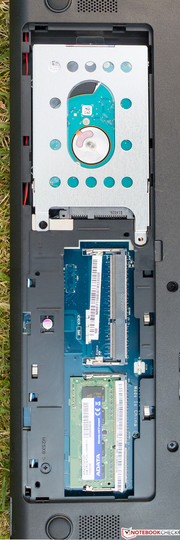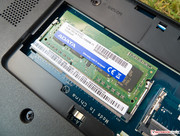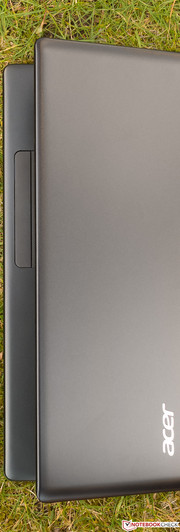Review Acer Aspire E1-572G-54204G50Mnkk Notebook

For the original German review, see here.
The Taiwanese manufacturer Acer is notorious for its virtually uncountable laptop models. The laptops from the E1-line are gathered in the affordable consumer range, and face countless competitors, for example from Toshiba and Lenovo. The two comparison devices also come from these manufacturers. Toshiba's Satellite C55-A-1D5 still relies on the Ivy Bridge Intel Core i5-3230M CPU (2x 2.6 - 3.2 GHz, Hyperthreading, TDP: 35 W), which has a higher clock than the i5-4200U (2x 1.6 - 2.6 GHz, Hyperthreading, TDP: 15 W, Haswell) in the review sample. In return, it consumes more power and produces more waste heat. That also applies to the Core i5-4200M (2x 2.5 - 3.1 GHz, Hyperthreading, TDP: 37 W, Haswell) that powers our second contender, Lenovo's IdeaPad Z510. The new - at least according to the name - AMD Radeon R7 M265 challenges the widely used Nvidia GeForce GT 740M in both the Toshiba and Lenovo laptop.
The budget was not enough for an IPS screen in any of the three contenders. The review sample and Lenovo's Z510 at least stand out from most contenders with a matte Full HD screen, while owners of Toshiba's laptop have to live with a reflective surface and a low resolution of 1366x768 pixels. All three laptops have roughly the same size, but the height of Toshiba's laptop of 33.4 mm (~1.3 inches) is thicker than the approximately 26 mm (~1.0 inches) of the E1-572G and Z510. In return, its depth is lower by about 2 cm (~0.8 inches). The weight ranges from 2.35 kg (~5.2 pounds; Acer) to 2.2 kg (~4.9 pounds; Lenovo). Several configurations of the review sample can be found here. Listing them all would go beyond the scope of this report.
Case
The casing is an old acquaintance that has accommodated the innards of various E1 models from Acer's 400 Euro (~$553) range either in an unchanged or only slightly modified state. It is completely made of black plastic. The base and lid's back feature a sleek, fingerprint-sensitive finish while the other surfaces are matte or textured. The keyboard's area is marginally submerged. Moderate pressure is enough to warp the base, but it does not produce any noises.
The lid also proves to be pliable. Pressure from the back is clearly seen on the front. Unlike the hinge of Acer's Aspire E1-522-45004G50Mnkk with a virtually identical casing, the review sample cannot be opened with one hand because the base lifts. The largest possible opening angle is approximately 155°. Overall, we find the casing fairly rigid and functional, but also a bit bland. Although the build does not exhibit any irregularities, such as sharp edges or uneven gaps, the choice of materials does not convey a high-quality impression.
Connectivity
The user is faced with minimalism in terms of interfaces; only the essential ports plus a VGA out are installed. The drawback of the standard casing is seen here: A second USB 3.0 port is perhaps not expected in a 400 Euro (~$553) laptop, but that is not true for a 600 Euro (~$829) device. At least no adapters are needed. In return, we have to criticize the interface distribution, which is concentrated in the front area. Particularly the cord of an external mouse annoyed us during practical use since it had to be plugged in on the right because an external hard drive was connected to the USB 3.0 port on the left. That the SD card slot on the front left edge is not closed with a dummy is unusual.
Communication
Qualcomm's Atheros AR956x is responsible for wireless communication via Wi-Fi b/g/n and Bluetooth 4.0. It supports both the 2.4 GHz band that is overburdened particularly in apartment buildings or city centers and the much less loaded 5 GHz band. We have until now only found Intel chips that support the new Gigabit Wi-Fi (IEEE 802.11 ac) in pricey business laptops and it is unlikely to feature in budget laptops at any time soon. The E1-572G's reception performance shone with an above average range through several walls and ceilings of an apartment building in the author's personal test setup. The transmission speed decreased fairly late when moving away from the router, but also relatively gradually.
Accessories
As common in this price range, there is not much to list; not even recovery media. Besides the power supply, the box only contained warranty documents and a setup guide. Acer does not offer any optional accessories specially made for the E1-line.
Maintenance
The somewhat difficult to open maintenance cover is only secured with one screw, and enables accessing the HDD and both memory banks of which only one is filled. The warranty is inevitably voided when the user accesses the fan or other innards because the entire base has to be removed.
Warranty
Acer includes its standard 24-month carry-in warranty. It can be upgraded to three years with international validity for approximately 70 Euros (~$97).
Input Devices
Keyboard
The available space of a 15.6-inch laptop allows Acer to use nearly a standard layout for the design of its unlit keyboard with number pad. Only the cursor keys feature a smaller than standard size. We would have, however, liked to see larger left shift and control keys. As usual, the function and cursor keys' second assignment for controlling brightness, volume, playing media can be opened via the blue FN key. It also enables activating the Acer Aspire E1-572G's energy-saving mode, disabling the screen or touchpad, etc. Unfortunately, none of the flat and lightly roughened keys features a practical status LED. Many contenders prove that this is not impossible in low-budget laptops, for example the 400 Euro (~$553) HP 250 G2 Office laptop.
It is also true for this E1 laptop that the keyboard features an agreeably long drop for today's laptop conditions. The crisp pressure point and moderate noise are just as appealing. The keyboard bed yields slightly when pressure is applied intentionally between the keys, but that is not significant in practical use. Though Acer will not win any prizes for design and beauty of this standard keyboard, the tester found typing even longer texts was easily possible.
Touchpad
In contrast to older E1 models, Acer has changed the touchpad's surface. It is lightly roughened and features a visibly striking texture. The pad provides clear feedback, and its accuracy and responsiveness were inconspicuous in the test. The surface is touch sensitive and recognizes gestures with up to three fingers. However, the pad could have been placed more centered to leave more room for the left palm. The driver of the Elan input device provides several, detailed options for individualization.
Display
A low-priced multimedia laptop with a matte Full HD screen is also rare. The 1920x1080 pixels in a 16:9 aspect ratio result in a decent pixel density of 141 ppi. Unfortunately, the image's sharpness is unsatisfactory, and is more or less visible depending on the color combination (e.g. fonts/background). Otherwise, the usual drawbacks of the selected TN technology are again noticed quite clearly in this case. The manufacturer also offers the E1-572G in versions with the HD resolution of 1366x768 pixels (TN, 100 ppi) as an alternative. Screens with a higher quality than the one in our review sample are not available.
The maximum brightness of 231 cd/m² is acceptable for the demanded price. It is only marginally below the average of current, equally sized multimedia laptops. The brightness is also available in battery mode. Users who have to or would like to work outdoors frequently will be better served with Lenovo's Z510, which achieves 317 cd/m² with its matte, Full HD screen. The glossy screen in Toshiba's Satellite C55 is roughly on par with the review sample. The illumination is largely homogeneous, and we did not observe bright spots or screen bleeding in the review sample.
| Acer Aspire E1-572G-54204G50Mnkk Radeon R7 M265, 4200U, Seagate Momentus Thin ST500LT0 12-9WS142 | Toshiba Satellite C55-A-1D5 GeForce GT 740M, 3230M, Toshiba MQ01ABF050 | Lenovo IdeaPad Z510 GeForce GT 740M, 4200M, Seagate ST500LM000 Solid State Hybrid Drive | |
|---|---|---|---|
| Display | 1% | -2% | |
| Display P3 Coverage (%) | 52.2 | 53.7 3% | 50.8 -3% |
| sRGB Coverage (%) | 73.8 | 73.5 0% | 74.4 1% |
| AdobeRGB 1998 Coverage (%) | 54.1 | 53.7 -1% | 52.5 -3% |
| Screen | 27% | 2% | |
| Brightness middle (cd/m²) | 231 | 247 7% | 317 37% |
| Brightness (cd/m²) | 231 | 232 0% | 295 28% |
| Brightness Distribution (%) | 80 | 81 1% | 73 -9% |
| Black Level * (cd/m²) | 0.63 | 0.36 43% | 0.97 -54% |
| Contrast (:1) | 367 | 686 87% | 327 -11% |
| Colorchecker dE 2000 * | 10.16 | 6.08 40% | 8.52 16% |
| Greyscale dE 2000 * | 10.99 | 7.7 30% | 10.06 8% |
| Gamma | 3.11 71% | 2.41 91% | 2.51 88% |
| CCT | 11807 55% | 9379 69% | 10564 62% |
| Color Space (Percent of AdobeRGB 1998) (%) | 49.38 | 51.2 4% | 48.76 -1% |
| Total Average (Program / Settings) | 14% /
19% | 0% /
1% |
* ... smaller is better
| |||||||||||||||||||||||||
Brightness Distribution: 80 %
Center on Battery: 231 cd/m²
Contrast: 367:1 (Black: 0.63 cd/m²)
ΔE ColorChecker Calman: 10.16 | ∀{0.5-29.43 Ø4.78}
ΔE Greyscale Calman: 10.99 | ∀{0.09-98 Ø5}
49.38% AdobeRGB 1998 (Argyll 1.6.3 3D)
54.1% AdobeRGB 1998 (Argyll 3D)
73.8% sRGB (Argyll 3D)
52.2% Display P3 (Argyll 3D)
Gamma: 3.11
CCT: 11807 K
Clearly below average, though not yet in an abysmal area, we find the low contrast of just 367:1. The black level of 0.63 cd/m² only reaches the average owing to the ratio between brightness and contrast. This is confirmed subjectively. The reproduction of black is quite good. While mostly important for professional image editors, the color space coverage is surprising. The approximate 50 percent AdobeRGB coverage is below average and anything higher should not be expected from a notebook in this price range, but this has little significance in typical day-to-day use and browsing. Both comparison units accomplish this as well though. The measured rate, unfortunately, does not correspond to real-life use in the tester's opinion.
The fact that the color accuracy of the screen in our Acer Aspire E1-572G-54204G50Mnkk is disappointing supports this subjective view. A DeltaE rate of over ten in both the grayscale and ColorChecker is far too high, and cause a clear bluish cast on this screen. However, this bluish cast might also be intentional, especially in many low-budget laptops because most people perceive a cooler balance as crisper. When the average layperson looks at several devices next to each other in a store, the device with a higher color temperature will be preferred. The DeltaE rate drops to 6 to 5 after calibration, and the bluish cast disappears completely. Instead, neutral gray shifts slightly in a clay-colored olive green that is not as evident as the much stronger bluish cast before calibration. Neither contender performs much better here either. Also striking is the Gamma rate of 3.11 that is quite remote from the target of 2.2 (Windows).
As the screenshot "Ideal outdoors" in the picture gallery on the right proves, the matte and bright screen can be positioned so that working outdoors is fun. This is even truer in cloudy conditions. The left screenshot below this paragraph shows sunlight from the side, and the right one proves that the screen is unusable when the sun shines directly on the screen.
TN screens and viewing angle stability are simply two things that do not match, and even a few improvements in recent years have not fundamentally changed that. We, however, have to attest a particularly weak performance of our review sample in this field. The typical TN image errors, such as color deviations, a milky image impression, and inverting, occur to a considerable degree when changing the horizontal or vertical viewing angle even very marginally. The screen offers Full HD, is matte and still fairly bright - but here we have found the inevitable drawback of this price range after all.
Performance
The installed, very energy-efficient Intel Core i5-4200U all-round CPU in our review sample comes from the latest Haswell generation, and is not for nothing found in so many current laptops made for different needs. It is supported by 4 GB of working memory and the new mid-range AMD Radeon R7 M265 graphics solution with 2 GB of dedicated memory. It has enough power for MS Office, more demanding tasks like image editing, and even for a few up-to-date games that are not explicitly developed for four or more physical cores.
Processor
The significantly increased energy efficiency and slightly improved per-MHz performance of a TDP of only 15 Watt in contrast to the former Ivy Bridge generation predestine the Intel Core i5-4200U CPU (2x 1.6 - 2.6 GHz, Hyperthreading, 22 nm process) for use in laptops starting at a screen size of 11 inches. These small devices are often invariably designed for mobility. This is definitely not the case for our review sample. However, the runtime naturally benefits from the low consumption. It would otherwise not be possible that the smaller 37 Wh battery in the Aspire achieved longer runtimes in all tests than, for example, Lenovo's Z510 equipped with Intel's Core i5-4200M (2x 2.5 - 3.1 GHz, Hyperthreading, TDP: 37 W), which has a battery capacity of 48 Wh (+30%).
When both cores are loaded, 2.3 GHz can be achieved via Turbo. The upper limit, for the rare case that only one core is loaded, is 2.6 GHz. As described in Performance, the processor finds its limits in consistently parallelized software, such as a few games or 3D rendering programs.
Compared with laptops powered by the same CPU, the performance of the processor in the E1-572G is exactly on the level expected. Due to their higher clock rates, both contenders in the test surpass it in Cinebench R11.5 by 22 to 40% depending on the single benchmark. The Multi-GPU test did not cause throttling; the specified rates of 2 x 2.3 GHz could be maintained stably. Thus, the Aspire easily passed the most important test for practical use - but unfortunately only in AC mode. The core clock dropped to the base rate of 1.6 GHz when the power supply was removed. We checked whether this affects the mobile gaming performance below.
System Performance
The hard drive and/or SSD performance are always considered in the PCMark 7 scores, although their significance differs depending on each benchmark. This has to be kept in mind when looking at the results because Lenovo's IdeaPad Z510 is the only one of the three devices that additionally sports an SSD cache beside the HDD. Consequently, the Z510 also easily takes the lead, but also because it features the fastest processor of the three. The review sample and Toshiba are roughly on par. The Satellite C55-A-1D5 benefits from its higher CPU clock, and Acer's Aspire from the more modern CPU architecture. This again leads to the impression of a sufficiently powered laptop that would gain less from a faster CPU than from an SSD. Though application and system starts are not lightening fast, they are quick. Only short delays were noticed when switching between several simultaneously opened programs and browser tabs.
| PCMark 7 Score | 2742 points | |
| PCMark 8 Home Score Accelerated | 3595 points | |
| PCMark 8 Creative Score Accelerated | 3292 points | |
| PCMark 8 Work Score Accelerated | 3906 points | |
Help | ||
Storage Devices
We just mentioned the possible advantages of an SSD cache, and now this: Lenovo's IdeaPad Z510 is sluggish in sequential read of the specialized HDD/SSD benchmark CrystalDiskMark 3.0. Instead of going in-depth about this unusually low performance here, we would like to point out the hybrid drive's lead in Read 4k and Read 4k QD32, which is more significant for real-life use. Roughly speaking, they simulate the performance of reading small data blocks randomly distributed on the HDD, which is typical for system and program starts. Especially compared with the overall low performance of the drive in the review sample, which lies at the lower end of the midfield in the overall comparison with laptops based on an HDD, advantages ranging from 97 to 122% are more than evident, and also explain the better system performance in contrast to the IdeaPad Z510's SSD cache. HD Tune records roughly the same scores for all hard drives, but multiple repetitions of the test on Lenovo's laptop clearly reduced the access times.
| Acer Aspire E1-572G-54204G50Mnkk Radeon R7 M265, 4200U, Seagate Momentus Thin ST500LT0 12-9WS142 | Toshiba Satellite C55-A-1D5 GeForce GT 740M, 3230M, Toshiba MQ01ABF050 | Lenovo IdeaPad Z510 GeForce GT 740M, 4200M, Seagate ST500LM000 Solid State Hybrid Drive | |
|---|---|---|---|
| CrystalDiskMark 3.0 | 17% | 59% | |
| Read Seq (MB/s) | 88.6 | 97.5 10% | 51.3 -42% |
| Read 4k (MB/s) | 0.258 | 0.305 18% | 0.507 97% |
| Read 4k QD32 (MB/s) | 0.572 | 0.697 22% | 1.267 122% |
Graphics Card
We have not examined very many laptops featuring AMD's new mid-range Radeon R7 265M graphics solution. In terms of price, Acer's Aspire E1-572G in the tested configuration is a direct competitor of basic multimedia laptops for approximately 600 Euros (~$829), and should thus have to face graphics cards on the level of the (still) very wide spread Nvidia GeForce GT 740M or slightly weaker. The available Nvidia GK208 only features a 64-bit memory bus while the Radeon R7 is technically a largely new edition of the well-known Radeon HD 8750M with 128 bits. A GPU clock rate (standard) of 825 GHz (AMD) faces up to 980 MHz from the 740M.
The CPU has the lowest impact on the pure graphics tests in 3DMark (2013). The resulting impression is mixed. However, it can be said that Toshiba's C55-A-1D5 comes in last in most single benchmarks, and sometimes considerably lags behind especially compared with the similarly equipped Lenovo Z510. Though our review sample sports the weakest and more frugal CPU of the three devices, it can compete with both contenders in the Cloud Gate benchmark (DX 10, medium settings). Acer's review sample is almost just as fast as Acer's Aspire E1-572G-54204G75Mnkk with the former chip of the Radeon R7 M265 that we additionally used for comparison. The review sample scored unexpectedly poorly in the plainly designed Cloud Gate DirectX 9 benchmark. 3DMark 11 recorded a tie between the Aspire and IdeaPad, but both only had a slight lead on the Satellite.
| Acer Aspire E1-572G-54204G50Mnkk Radeon R7 M265, 4200U, Seagate Momentus Thin ST500LT0 12-9WS142 | Toshiba Satellite C55-A-1D5 GeForce GT 740M, 3230M, Toshiba MQ01ABF050 | Lenovo IdeaPad Z510 GeForce GT 740M, 4200M, Seagate ST500LM000 Solid State Hybrid Drive | Acer Aspire E1-572G-54204G75Mnkk Radeon HD 8750M, 4200U, TOSHIBA MQ01ABD075 | |
|---|---|---|---|---|
| 3DMark | -6% | 15% | 20% | |
| 1280x720 Ice Storm Standard Score (Points) | 38911 | 33331 -14% | 52373 35% | 50492 30% |
| 1280x720 Ice Storm Standard Graphics (Points) | 45208 | 56946 26% | 59777 32% | 65200 44% |
| 1280x720 Cloud Gate Standard Score (Points) | 5357 | 4037 -25% | 5375 0% | 5433 1% |
| 1280x720 Cloud Gate Standard Graphics (Points) | 8299 | 7451 -10% | 7609 -8% | 8552 3% |
| 3DMark 11 | ||||
| 1280x720 Performance (Points) | 2012 | 1793 -11% | 2061 2% | 1885 -6% |
| Total Average (Program / Settings) | -9% /
-7% | 9% /
12% | 7% /
14% |
| 3DMark 11 Performance | 2012 points | |
| 3DMark Ice Storm Standard Score | 38911 points | |
| 3DMark Cloud Gate Standard Score | 5357 points | |
| 3DMark Fire Strike Score | 1211 points | |
Help | ||
Gaming Performance
Many fairly up-to-date and graphically demanding games can be played in medium to high settings with this graphics card. However, the system is already overburdened in the unsightly minimum settings (resolution: 1024x768 pixels) with the latest top graphic hits, such as Assassins Creed Black Flag, Battlefield 4 or the extremely performance devouring Company of Heroes 2. It is usually only enough for high settings in older or less demanding games like StarCraft II or Diablo. Exceptions are Batman Arkham City (sketchy in high), Dishonored, and Bioshock Infinite, which are all based on the Unreal Engine 3. However, we look at the average fps rates in this statement. The minimum fps are more important, particularly in shooters, so that the frame rate often drops below the magic limit of 30 fps exactly when there is a lot of action. 30 fps will not satisfy ambitious players; instead they will rightly fear being at a disadvantage with a minimum frame rate of below 40 or even 50 when playing against others with stronger hardware.
Too bad that our suspicion mentioned above was confirmed. The gaming performance is not fully available in battery mode. For example, the average frame rates in Bioshock Infinite (medium settings) dropped to 23 fps from 40 fps in AC mode.
| low | med. | high | ultra | |
|---|---|---|---|---|
| StarCraft 2 (2010) | 149 | 55 | 37 | 22 |
| Total War: Shogun 2 (2011) | 127.7 | 31.96 | 14.21 | |
| Batman: Arkham City (2011) | 94 | 74 | 31 | 15 |
| The Elder Scrolls V: Skyrim (2011) | 55.1 | 38.51 | 28.67 | 16.65 |
| Anno 2070 (2011) | 109.6 | 50.9 | 31.22 | 15.27 |
| Diablo III (2012) | 87.1 | 59 | 48.4 | 31.46 |
| Max Payne 3 (2012) | 26.98 | 24.78 | ||
| Dishonored (2012) | 68.3 | 55 | 48.55 | 27.37 |
| Medal of Honor: Warfighter (2012) | 59.3 | 39.09 | 30.64 | 11.89 |
| Call of Duty: Black Ops 2 (2012) | 79.8 | 46.54 | 26.6 | 18.18 |
| Hitman: Absolution (2012) | 30.77 | 25.29 | 18.19 | 7.96 |
| Crysis 3 (2013) | 32.89 | 21 | ||
| Tomb Raider (2013) | 74 | 45.6 | 31.4 | 14.8 |
| BioShock Infinite (2013) | 71.8 | 39.92 | 33.31 | 11.03 |
| Company of Heroes 2 (2013) | 30.09 | 24.04 | 13.8 | |
| Dota 2 (2013) | 81.5 | 55.1 | 27.68 | |
| Battlefield 4 (2013) | 24.25 | 17.1 | ||
| Assassin´s Creed IV: Black Flag (2013) | 16.91 | 13.05 |
Emissions
System Noise
The fan never really stops spinning. Of the four speeds, at most the second lowest is active when browsing, working or watching YouTube videos in HD full screen mode. Reaching (a subjectively quiet) 32 dB(A), the test unit is exactly within the average range of comparable laptops. The 40.6 dB(A) registered while gaming, where the corresponding demand normally activates the two higher levels, is in the better third. The tester heard a clear hum that was not penetrating during the game owing to the fan's pleasant characteristic. The differences to the Satellite and IdeaPad are marginal; the impression is balanced overall.
Noise level
| Idle |
| 30.3 / 32 / 32 dB(A) |
| HDD |
| 30.4 dB(A) |
| DVD |
| 36 / dB(A) |
| Load |
| 36.2 / 40.6 dB(A) |
 | ||
30 dB silent 40 dB(A) audible 50 dB(A) loud |
||
min: | ||
Temperature
The temperature of at most 32 °C (89.6 °F) in low load is no issue. However, it could just exceed 41 °C (105.8 °F) on the underside's center during long-lasting load. It is a matter of opinion whether that is uncomfortable. Since the waste heat is largely discharged from the casing's side, it is unlikely that heat will accumulate even when the laptop is used on a soft surface. The CPU and GPU temperatures clearly remain below critical rates in every situation.
(±) The maximum temperature on the upper side is 41.6 °C / 107 F, compared to the average of 36.9 °C / 98 F, ranging from 21.1 to 71 °C for the class Multimedia.
(±) The bottom heats up to a maximum of 41.4 °C / 107 F, compared to the average of 39.2 °C / 103 F
(+) In idle usage, the average temperature for the upper side is 27.9 °C / 82 F, compared to the device average of 31.3 °C / 88 F.
(+) The palmrests and touchpad are cooler than skin temperature with a maximum of 31.6 °C / 88.9 F and are therefore cool to the touch.
(-) The average temperature of the palmrest area of similar devices was 28.7 °C / 83.7 F (-2.9 °C / -5.2 F).
Speakers
Matching the multimedia claim, the speakers do a decent job and completely fill roughly 25 m² (~269 sq ft) with sound. None of the various sources annoyed us with distortions or fluctuating levels even at maximum volume. Despite (or because of) the clean settings in the driver, we could even enjoy hints of dynamics alongside a balanced, reasonably natural reproduction. However, surround sound was largely neglected.
Energy Management
Power Consumption
Acer's Aspire E1-572G-54204G50Mnkk does not consume any measurable power when turned off, and it is within narrow limits with a standby consumption of 0.2 Watts - exemplary. Compared with other multimedia laptops of the same size from the past twelve months, it is in the top third (min) and midfield (avg, max) in idle mode. It also positions itself among the 10 most energy-efficient laptops in load (avg). Neither the Toshiba nor the Lenovo contender even comes close to that.
| Acer Aspire E1-572G-54204G50Mnkk Radeon R7 M265, 4200U, Seagate Momentus Thin ST500LT0 12-9WS142 | Toshiba Satellite C55-A-1D5 GeForce GT 740M, 3230M, Toshiba MQ01ABF050 | Lenovo IdeaPad Z510 GeForce GT 740M, 4200M, Seagate ST500LM000 Solid State Hybrid Drive | |
|---|---|---|---|
| Power Consumption | -44% | -11% | |
| Idle Minimum * (Watt) | 5.7 | 8.5 -49% | 7 -23% |
| Idle Average * (Watt) | 10.1 | 12 -19% | 10.2 -1% |
| Idle Maximum * (Watt) | 12.5 | 13.3 -6% | 10.4 17% |
| Load Average * (Watt) | 40.3 | 71.6 -78% | 57.9 -44% |
| Load Maximum * (Watt) | 53.7 | 89.5 -67% | 55.4 -3% |
* ... smaller is better
| Off / Standby | |
| Idle | |
| Load |
|
Key:
min: | |
Battery Runtime
Right on the spot: Acer promises a battery runtime of four hours, and the practical Wi-Fi browsing test using energy-saving mode, a screen brightness of 150 cd/m² resulted in four hours and one minute, which is only slightly below the average of current and comparable laptops. Not even one and a half hours of mobile gaming would be possible, but we would not recommend that due to the performance decrease in battery mode. That is quite a poor rate. However, the DVD runtime using maximum brightness and volume, and disabled communication modules might be interesting. Virtually no movie has a length of three hours so that there will usually even be enough reserves for other activities.
Verdict
Acer's Aspire E1-572G-54204G50Mnkk might be unremarkable, and only AMD's new graphics and the Full HD resolution let it stand out from its contenders in this price range, but it does its job reliably without any evident, major flaws. As can be seen in the many gaming benchmarks in this report, and the comparison chart far below, the Radeon R7 265M largely operates on par with the widespread Nvidia GeForce GT 740M. Though that does not apply to the latest graphic hits, such as Battlefield 4 and Assassin's Creed Black Flag, games with such high demands cannot be enjoyably played on comparable laptops either. Our tested Aspire will play current titles well in medium settings and older titles effortlessly in higher settings. The R7 265M is not any more future secure than the GT 740M. In terms of the screen, the high resolution for this price range is pleasing, but a few compromises have to be made elsewhere.
As to the casing, CPU and input devices, they are solid mass-produced goods that are installed in many other models from the E1 series in various combinations. In our opinion, Acer has done a better job with temperature, noise, and not least the energy management than many competitors. It is too bad that the good performance is not maintained in battery mode. The connectivity also slightly remains behind the expectations. Nevertheless, we believe that opting for the Aspire E1-572G will not be a big mistake. Perhaps certain buyers will want to support AMD with their purchase so that Nvidia's dominance on the mobile graphics market does not expand even more.
| Total War: Shogun 2 | |
| 1280x1024 CPU (sort by value) | |
| Acer Aspire E1-572G-54204G50Mnkk | |
| Toshiba Satellite C55-A-1D5 | |
| 1920x1080 high AA:ML AF:16x (sort by value) | |
| Acer Aspire E1-572G-54204G50Mnkk | |
| Toshiba Satellite C55-A-1D5 | |
| 1280x720 moderate AF:trilinear (sort by value) | |
| Acer Aspire E1-572G-54204G50Mnkk | |
| Toshiba Satellite C55-A-1D5 | |
| 1024x768 low (sort by value) | |
| Acer Aspire E1-572G-54204G50Mnkk | |
| Toshiba Satellite C55-A-1D5 | |
| Anno 2070 | |
| 1920x1080 Very High Preset AA:on AF:4x (sort by value) | |
| Acer Aspire E1-572G-54204G50Mnkk | |
| Toshiba Satellite C55-A-1D5 | |
| 1366x768 High Preset AA:on AF:2x (sort by value) | |
| Acer Aspire E1-572G-54204G50Mnkk | |
| Toshiba Satellite C55-A-1D5 | |
| Lenovo IdeaPad Z510 | |
| 1366x768 Medium Preset AA:on (sort by value) | |
| Acer Aspire E1-572G-54204G50Mnkk | |
| Toshiba Satellite C55-A-1D5 | |
| Lenovo IdeaPad Z510 | |
| 1024x768 Low Preset (sort by value) | |
| Acer Aspire E1-572G-54204G50Mnkk | |
| Toshiba Satellite C55-A-1D5 | |
| Lenovo IdeaPad Z510 | |
| Tomb Raider | |
| 1920x1080 Ultra Preset AA:FX AF:16x (sort by value) | |
| Acer Aspire E1-572G-54204G50Mnkk | |
| Toshiba Satellite C55-A-1D5 | |
| Toshiba Satellite C55-A-1D5 | |
| Toshiba Satellite C55-A-1D5 | |
| 1366x768 High Preset AA:FX AF:8x (sort by value) | |
| Acer Aspire E1-572G-54204G50Mnkk | |
| Toshiba Satellite C55-A-1D5 | |
| Toshiba Satellite C55-A-1D5 | |
| Lenovo IdeaPad Z510 | |
| 1366x768 Normal Preset AA:FX AF:4x (sort by value) | |
| Acer Aspire E1-572G-54204G50Mnkk | |
| Toshiba Satellite C55-A-1D5 | |
| Toshiba Satellite C55-A-1D5 | |
| Lenovo IdeaPad Z510 | |
| 1024x768 Low Preset (sort by value) | |
| Acer Aspire E1-572G-54204G50Mnkk | |
| Toshiba Satellite C55-A-1D5 | |
| Toshiba Satellite C55-A-1D5 | |
| Lenovo IdeaPad Z510 | |
| BioShock Infinite | |
| 1920x1080 Ultra Preset, DX11 (DDOF) (sort by value) | |
| Acer Aspire E1-572G-54204G50Mnkk | |
| Toshiba Satellite C55-A-1D5 | |
| 1366x768 High Preset (sort by value) | |
| Acer Aspire E1-572G-54204G50Mnkk | |
| Toshiba Satellite C55-A-1D5 | |
| 1366x768 Medium Preset (sort by value) | |
| Acer Aspire E1-572G-54204G50Mnkk | |
| Toshiba Satellite C55-A-1D5 | |
| 1280x720 Very Low Preset (sort by value) | |
| Acer Aspire E1-572G-54204G50Mnkk | |
| Toshiba Satellite C55-A-1D5 | |
| Company of Heroes 2 | |
| 1920x1080 Maximum / Higher / High AA:High (sort by value) | |
| Acer Aspire E1-572G-54204G50Mnkk | |
| Toshiba Satellite C55-A-1D5 | |
| 1366x768 High AA:Medium (sort by value) | |
| Toshiba Satellite C55-A-1D5 | |
| 1366x768 Medium AA:Off (sort by value) | |
| Acer Aspire E1-572G-54204G50Mnkk | |
| Toshiba Satellite C55-A-1D5 | |
| 1024x768 Minimum / Low / Off AA:Off (sort by value) | |
| Acer Aspire E1-572G-54204G50Mnkk | |
| Toshiba Satellite C55-A-1D5 | |
| Batman: Arkham City | |
| 1920x1080 Extreme Preset DX11 AA:4x MS (sort by value) | |
| Acer Aspire E1-572G-54204G50Mnkk | |
| 1366x768 High Preset DX11 AA:2x MS (sort by value) | |
| Acer Aspire E1-572G-54204G50Mnkk | |
| Lenovo IdeaPad Z510 | |
| 1366x768 Medium Preset (sort by value) | |
| Acer Aspire E1-572G-54204G50Mnkk | |
| Lenovo IdeaPad Z510 | |
| 1024x768 Low Preset (sort by value) | |
| Acer Aspire E1-572G-54204G50Mnkk | |
| Lenovo IdeaPad Z510 | |
| The Elder Scrolls V: Skyrim | |
| 1920x1080 Ultra Preset AA:8x AF:16x (sort by value) | |
| Acer Aspire E1-572G-54204G50Mnkk | |
| 1366x768 High Preset AA:8x AF:8x (sort by value) | |
| Acer Aspire E1-572G-54204G50Mnkk | |
| Lenovo IdeaPad Z510 | |
| 1366x768 Medium Preset AA:4x (sort by value) | |
| Acer Aspire E1-572G-54204G50Mnkk | |
| Lenovo IdeaPad Z510 | |
| 1280x720 Low Preset (sort by value) | |
| Acer Aspire E1-572G-54204G50Mnkk | |
| Lenovo IdeaPad Z510 | |
| Battlefield 4 | |
| 1366x768 High Preset (sort by value) | |
| Lenovo IdeaPad Z510 | |
| 1366x768 Medium Preset (sort by value) | |
| Acer Aspire E1-572G-54204G50Mnkk | |
| Lenovo IdeaPad Z510 | |
| 1024x768 Low Preset (sort by value) | |
| Acer Aspire E1-572G-54204G50Mnkk | |
| Lenovo IdeaPad Z510 | |














